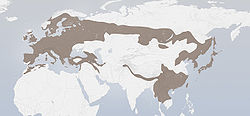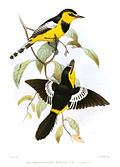Garrulus
Appearance
| Garrulus | |
|---|---|

| |
| Black-headed jay (G. lanceolatus), India | |
| Scientific classification | |
| Kingdom: | Animalia |
| Phylum: | Chordata |
| Class: | Aves |
| Order: | Passeriformes |
| Family: | Corvidae |
| Subfamily: | Corvinae |
| Genus: | Garrulus Brisson, 1760 |
| Type species | |
| Garrulus glandarius Linnaeus, 1758
| |
| Species | |
| |
Garrulus is a genus of Old World jays, passerine birds in the family Corvidae.
Taxonomy and systematics
[edit]The genus was established by French zoologist Mathurin Jacques Brisson in 1760.[1] The type species is the Eurasian jay (Garrulus glandarius).[2][3] The name Garrulus is a Latin word meaning chattering, babbling or noisy.[4]
Species
[edit]Three species are currently accepted,[5] though some authors split Eurasian jay into three species, thereby accepting five species in the genus.[6]
| Common name | Scientific name and subspecies | Range | Size and ecology | IUCN status and estimated population |
|---|---|---|---|---|
| Eurasian jay | Garrulus glandarius (Linnaeus, 1758) 34 subspecies in three main groups
|
Western Europe and north-western Africa east to the Indian subcontinent and Eastern Asia
|
Size: 32–37 cm Habitat: woodland Diet: omnivorous; specialising in acorns in autumn and winter |
LC
|
| Black-headed jay | Garrulus lanceolatus Vigors, 1830 Monotypic
|
Eastern Afghanistan east along the Himalayas, through northern India to Nepal and Bhutan | Size: 33 cm Habitat: woodland Diet: omnivorous; specialising in acorns in autumn and winter |
LC
|
| Lidth's jay | Garrulus lidthi (Bonaparte, 1850) Monotypic
|
Ryukyu Islands south of Japan | Size: 38 cm Habitat: woodland Diet: omnivorous |
VU
|
References
[edit]Wikimedia Commons has media related to Garrulus.
Wikispecies has information related to Garrulus.
- ^ Brisson, Mathurin Jacques (1760). Ornithologie, ou, Méthode contenant la division des oiseaux en ordres, sections, genres, especes & leurs variétés (in French and Latin). Vol. 1. Paris: Jean-Baptiste Bauche. p. 30.
- ^ Mayr, Ernst; Greenway, James C. Jr, eds. (1962). Check-list of birds of the world. Vol. 15. Cambridge, Massachusetts: Museum of Comparative Zoology. p. 228.
- ^ Brisson, Mathurin Jacques (1760). Ornithologie, ou, Méthode contenant la division des oiseaux en ordres, sections, genres, especes & leurs variétés (in French and Latin). Vol. 2. Paris: Jean-Baptiste Bauche. p. 47.
- ^ Jobling, James A. (2010). The Helm Dictionary of Scientific Names. London, UK: Christopher Helm. p. 171. ISBN 978-1-4081-2501-4.
- ^ Gill, Frank; Donsker, David, eds. (2017). "Crows, mudnesters & birds-of-paradise". World Bird List Version 7.2. International Ornithologists' Union. Retrieved 28 May 2017.
- ^ Hoyo, Josep del (2020). All the Birds of the World. Barcelona: Lynx edicions. p. 555. ISBN 978-84-16728-37-4.











